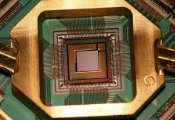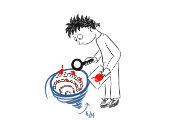Going Beyond Energy: Ground-State Properties Unlocked in a Certifiable and Scalable Way
July 22, 2024 -- A set of particles that interact with each other tends to minimize its energy. When the whole system actually reaches the minimum energy, its description is given by the so-called ‘ground-state’, or state of minimal energy. Scientists are thus very interested in discovering and analyzing its properties, which of course include -but are not limited to- the energy. For instance, magnetic and conduction properties are other worthwhile knowing features, to name just a few.
However, discovering the exact value of these ground-state properties becomes harder as the number of particles increases, reaching a point where even a supercomputer would not be able to find the solution. To circumvent this obstacle, there are two numerical methods that bound the energy of the ground state: the variational and the relaxation methods. They provide an upper and a lower bound, respectively. This means that, even though the exact ground-state energy is, strictly speaking, still uncertain, it will be for sure contained between those two values. The closer the upper and the lower bound are, the less uncertainty there will be on the energy.
Variational and relaxation methods have proven to be really effective, providing tight enough bounds to be able to infer the ground-state energy with the desired accuracy in a wide variety of physical problems. Nevertheless, when these techniques are applied to other different properties, it is not possible to know whether the obtained quantities are close to the real value, as they are no longer ensured to be upper or lower bounds. Finding non-trivial bounds would not only allow scientists to check if the information provided by variational methods was on the right path, but would also lead by itself to a certified estimation on the real value of these ground-state properties.
This issue has now been tackled by an international team in a Physical Review X article, with Dr. Jie Wang from the Chinese Academy of Sciences as its leading author and the participation of ICFO researchers Dr. Jacopo Surace and ICREA Prof. Antonio Acín, as well as the Perimeter Institute for Theoretical Physics, Université Grenoble Alpes, Sobbornne Université, Collège de France, ESAT, Inria Paris-Saclay, Institute Polytechnique of Paris, LAAS-CNRS and the Institute of Mathematics from Toulouse. They show how, by taking into account the variational and relaxation results for the energy, one can derive certifiable bounds on other ground-state properties in a scalable way.
Towards the certification of any ground-state property
With their approach, consisting in a numerical method called semi-definite programming (SDP) relaxation, one can be sure that the actual value of a given ground-state property lays within the obtained range. Again, just as what happened with the energy, the ability to get the limiting bounds closer will increase the accuracy of the predictions. The novelty of the article lies in the fact that the energy bounds given by the variational and relaxation methods are now considered. The strategy leads to a significant improvement (by an order of magnitude) with respect to previous attempts, being the first time that a method exhibits competitive performance when certifying ground-state properties beyond the energy.
The team benchmarked their method with several models (Heisenberg models) that described an array of interacting particles with spin ½ (for instance, electrons). The addressed properties were the spin-spin correlation functions, which give direct information about whether the system behaves ferromagnetically or antiferromagnetically. In all the cases their SDP relaxation provided bounds in agreement with the expectations. They also successfully bounded the spin-spin correlation function of a particular system (J1 – J2 square lattice Heisenberg model for 100 spins) whose exact calculation is currently out of reach, showcasing the potential of the proposed technique.
Although SDP relaxations are just in their infancy and many improvements can be made to bring upper and lower bounds closer together, the results obtained show great promise. Moreover, their tool is completely general, so in principle it could be applied to any other observable of interest. “Our method offers deep insights into the understanding of phases of matter, how particles arrange to minimize their energy, which is essential to understand many phenomena, from chemical processes to material design”, claims ICREA Prof. at ICFO Antonio Acín. “And we are confident that our approach will become a central tool in the study of ground-state problems, a ubiquitous issue in science”.




































